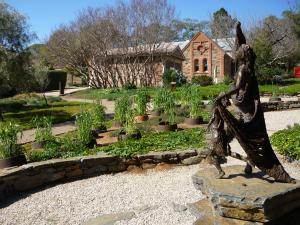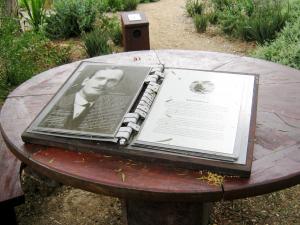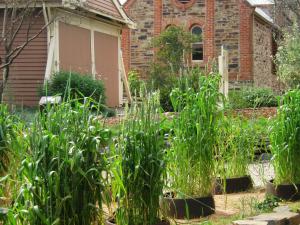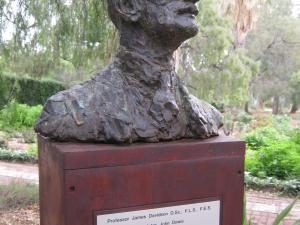Garden of Discovery
Come to learn, have fun and explore in the Garden of Discovery!
Designed with pathways, soundscapes, outdoor books and interpretive signage, it highlights some of the internationally significant achievements of South Australian scientists in environmental and agricultural science at the Waite Campus.
Development of the Garden of Discovery concept
In 1995, a design team of Viesturs Cielens, Susan Phillips and Berenice Carrington, along with input from the wider community developed a masterplan for the gardens of the Urrbrae House Historic Precinct. It was decided to recreate some of the historical elements of the garden, but also to create new thematic garden rooms. These rooms make reference to the history of Peter Waite and the scientific achievements of the campus, and are stimulating interpretative places for people of all ages to enjoy. Artist Dianne Longley collaborated on the design for the Garden of Discovery and the attractive inlaid pavers were made by Lynn Elzinga-Henry.
Cultural historian Denise Schumann developed the conceptual themes and narratives, described below, which overlay the garden design and provide the intellectual framework for the Science Discovery Trail. Informed by her extensive research and oral history projects she also authored the outdoor books and interpretive panels and produced the soundscapes.
The Garden of Discovery is divided into thematic sections
-
Beginnings
-
New directions
Since the early days of colonial settlement, Australia had a history of plant and animal breeding'. Fundamental genetics, however, was late in becoming established. After 1945, Australia seemed more connected to the world, and it was thought that as Australia was highly dependent on primary industry, it was necessary to strengthen research programs in the pure and applied sciences. From 1949 until 1955, there was a series of extremely important developments in the area of genetic studies, plant breeding and evaluation made at the Waite Institute.
-
Vision and revision
The work at Waite Institute has always involved changing attitudes towards biology and agriculture. The philosophy that the Australian conditions would dictate the nature of the research was an important one. The economic importance of Australian native flora was identified, and as a consequence, there was a growing commitment to preservation and conservation of native bush. Constance Eardley's life and work with Australian arid lands, is honoured in this section.
-
Keeping the faith
Grants, donations and supporters
Since 2009, with the collaboration of the Mediterranean Garden Society (SA Branch), a major refurbishment of the Garden of Discovery began. Members of the SAMGS donated and planted Australian native plants including eucalyptus, banksias, acacias and native grasses - some of these genera being subjects of research at The Waite. SAMGS members attend quarterly volunteer sessions organized by the university volunteer program to help with the maintenance of the garden.
University of Adelaide Garden Volunteers tend regularly the garden and help maintain the new plantings.
State and Federal Centenary Grants
History Trust of SA
National Science Week 2001
Davidson Family
Australian Council for the Arts
Arts SA Art for Public Places




